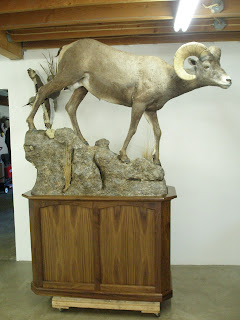Below is a letter I recently received from Shawn Joyce of Diizche Safari Adventures. I want to share this with my clients because it is written from a client’s perspective and touches on a very important topic. I believe it will be of interest to both my new and established clients.
Food for Thought
Today I was thinking about the joy I receive everyday when I view the mounted game in my home. To me each mount is a piece of art that captures the essence of a beautiful trophy that I have hunted. Through this art form the memories that surrounded the hunt are recalled and conveyed. For those who visit my home, they appreciate and enjoy the beauty of the animals. Visitors always want to learn more about the hunts, conservation through hunting, how the meat was utilized, and more often than not how the animal tasted.
While reflecting on the enjoyment of my mounts I thought about the way my mounts were professionally prepared with the highest attention to detail. When I began building a trophy room to enjoy I did not at first find a taxidermist with whom I wanted to have a lifetime relationship. You see my first mount was a black bear. I went to a local guy that assured me I would get a great mount. What I received was a great mount with “his” level of skills and not what I have now come to know as a great mount.
After that experience I learned that you can’t take the word of well meaning friends and sportsman you meet about great taxidermy work. For many, the definition of a great mount is defined by how little they had to pay for it and not necessarily the quality of work. You have to educate yourself and learn what goes into making a great mount. You should visit professional taxidermist shops, look at their work, and ask questions. Another part of this process is to understand that you will get what you pay for. When you find a skilled professional taxidermist their time and labor equals money. The ingredients for creating the mount are the small part of the total cost equation.
If a professional taxidermist advertizes a $500.00 deer mount, the plan is to assemble two deer a day. The taxidermist that is mounting two of these $500.00 deer will earn more profit per day than the taxidermist down the road spending two full days to mount one deer at $850.00. Even without discussing the intricate details, you can see where the taxidermist spending more time on your mount will have the opportunity to create an accurate representation of your trophy.
Why would a taxidermist spend two days mounting a deer, if it is possible to quickly mount two in one day? The difference is the personal pride in the finished product. I have come to understand specifically what goes into making a great mount. I hope you will consider detailing this information on your blog for those clients that want to better understand.
Shawn Joyce
After reading this short letter from Shawn, I decided to elaborate a little on the difference between the $500.00 and $850.00 deer mount he described. This should give you a better understanding of the difference between the two approaches.
Elsewhere on my blog the hunter can find links to projects that were completed in a low budget shop. They found their way here to be remounted. This is a very costly and completely preventable problem.
I will outline a few short cuts that the so called bargain taxidermists typically do to lower the price and still make a living. The first component deals with tanning. To save money they can send the skin out to a cheap tannery or they could tan the skin in house.
The next component deals with anatomy. To save time, which equates to money, he will not do any alteration for size, shape, or anatomy. This taxidermist will order a manikin that is close and preferably smaller so the skin will go on quickly. There will be no attention paid to the age of the deer. A deer that is 3 1/2 years old has a slimmer head than a 5 1/2 year old. He does not know this, because he has cut the entire eye socket away. He has no reference to head width or skull placement. The name of the game is to attract the guy looking for a deal and give it to him.
Believe it or not, this hunter is actually easier to please. He will not complain about poor work or bad service. Throughout my blog I have written many tutorials on this very subject. Most of all remember that the taxidermist that produces a $500.00 to $600.00 mount cannot get $850.00. The hunter should ask himself why. The taxidermist is not short changing himself, only the hunter is being short changed.
You must remember that what sets apart an everyday or average mount apart from a great mount are all the details. These start with high quality professional tanning and then include proper anatomy based upon eye socket width and measurements, manikin alterations, antler placement and eye set just to name a few. These details and steps take time to execute and time equals cost to the final product.
 |
| Dall sheep pinned and in the drying stage. |
